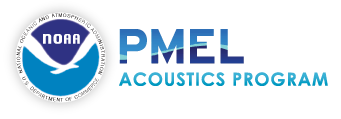MISSION
LOG, 25 May 2002 The
2002 season for Sound in the Sea has begun and we face the
same challenge faced by ocean explorers throughout the centuries:
foul weather! We are on the French research vessel, Le Suroit,
which sailed from Ponta Delgada in the Portugese Azores
on Saturday, May 18th and plan to deploy six
underwater hydrophone moorings in the North Atlantic to
explore the region acoustically. Although not in the path of any large storm,
the westerly winds have been sustained at 25-35 knots for
the entire period building up sea of 5-8 meters. Le Suroit is relatively small (52 meters, or 160')
so that we are being tossed about. Last night we recorded a 35 degree roll. In spite
of the weather, we have succeeded in deploying three moorings
already and are enroute to the fourth site.
As
we sailed from the Azores, we spent a few hours mapping
some of the volcanic features of the Azores using the ships
EM300 multibeam mapping sonar. Portugese geologists onboard have been compiling a map of the Azores
based on similar opportunities from multibeam capable vessels. We also have been sighting marine mammals for
comparison the hydrophone records and encountered a large
pod of mixed fin whales and blue whales near the Azores.
Rita Bento, a student at the University of the Azores who
has been working with Sound in the Sea, is on board to record
such observations.
The
team and the effort are truly international. The French
government, through its ocean agency IFREMER, are providing
all of the ship time and support. We have four French earth scientists on board,
including Dr. Jean Goslin of the Universite de Bretagne
Occidentale in Brest, who is our Chief Scientist for the
mission. There are three technicians provided by IFREMER to operate the multibeam
sonar. Besides the
three Portugese scientists already mentioned, and myself
(American), Dr. Haru Matsumoto, our senior engineer from
Sound in the Sea is here and is a citizen of Japan! NOAA’s Ocean Exploration Program is supporting our
participation including the costs of constructing the hydrophone
instruments. The
procedure to deploy a hydrophone mooring is as follows:
We must first identify an area of the seafloor which is
relatively flat for 5 - 10 km diameter. This is necessary
so that we can be certain of the length of mooring required
to suspend the hydrophone into the overlying SOFAR channel. Once a site has been identified, we measure the water
properties using an eXpendible BathyThermograph (or XBT)
and determine the precise depth of lowest sound speed (the
axis of the SOFAR channel). Knowing the water depth and the depth that we want to suspend the
hydrophone, we can construct a mooring of just the proper
length. Next we position the ship downwind 3-4 km and
begin slowly moving toward our desired deployment site as
we pay out the mooring into the water. First a large yellow float, with strobe light, flag
and floating line to aid in the eventual recovery of the
mooring next year. Then
the hydrophone instrument, which has been checked out onboard
and programmed to begin recording usually the next day.
Next 2,500 -4,500 meters of special mooring line design
not to stretch or vibrate (strum). Finally, an acoustic release device that can
be commanded to release the mooring and a large anchor composed
of surplus aircraft carrier anchor chain. When the ship reaches the desired point, the anchor
is released and the mooring in sent to the bottom to record
for a year until we return to pick it up. The final procedure is to acoustically “ping”
to the release above the anchor from various directions
to determine it’s exact location. This effort has been especially difficult this year
due again to the high seas which make the ship less maneuverable
and generate significant acoustic noise into the environment.
So
far, we have deployed the two hydrophones closest to the
Azores and the middle hydrophone on the western side. We are now steaming north to deploy the northwest
instrument. This
order is different that the original plan, but due again
to the westerly winds, we did not want to have to transit
east to west more than once! I will file another report on the way into France
next week.
|
||||
